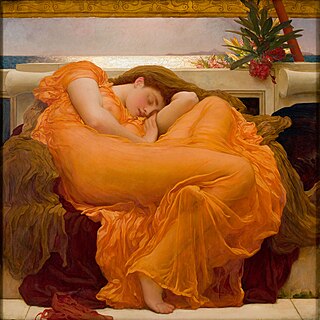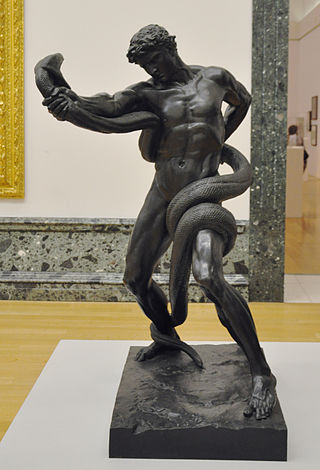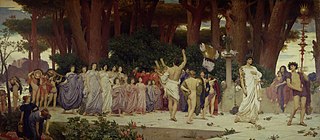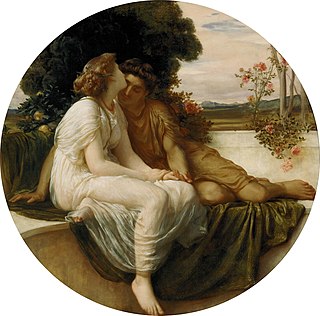| The Music Lesson | |
|---|---|
 | |
| Artist | Frederic Leighton |
| Year | 1877 |
| Medium | Oil on canvas |
| Dimensions | 93 cm× 95 cm(37 in× 37 in) |
| Location | Guildhall Art Gallery |

The Music Lesson is an oil painting by Frederic Leighton, first exhibited in 1877.
| The Music Lesson | |
|---|---|
 | |
| Artist | Frederic Leighton |
| Year | 1877 |
| Medium | Oil on canvas |
| Dimensions | 93 cm× 95 cm(37 in× 37 in) |
| Location | Guildhall Art Gallery |

The Music Lesson is an oil painting by Frederic Leighton, first exhibited in 1877.
The 1877 Exhibition of the Royal Academy of Arts included a picture fom Leighton's studio, entitled The Music Lesson. [1] Early in 1878 Leighton was appointed president of the jury on paintings at the Paris International Exhibition, to which exhibition he contributed Elijah in the Wilderness, TheMusic Lesson, and Captain Richard Burton, H.M.'s Consul at Trieste. [2]
Edgcumbe Staley admired the composition:
The masterly entanglement of the two lovely forms—typical and ideal—as they sit side by side on the black-and-white marble bench, is marked with intense sincerity. Nothing can exceed the delicate articulation of the hands of the two figures—mother and child, or sister. Their feet are chastely disposed and chiselled with the gentlest touch. The pose is easy and graceful. The loving way in which the elder figure places the child's hands upon the guitar as with the other hand she tunes the instrument is natural and convincing. The whole composition breathes an atmosphere of pure refinement and is the very embodiment of rhythm. The Eastern draperies are wonderfully arranged, every fold adding its light or shade in due ratio. The simple pale blue dress of the child accords absolutely with her tender carnations; whilst the white and gold-embroidered robe of the elder girl, or woman—loose and elegant—is in strict keeping, as regards good taste and the true sequence of colours. The bits of pomegranate—so often used as highest points by Leighton—are beautifully detailed. To show that the artist himself set great store by this picture, he has left a "figurine" group of the two female figures which he used for this composition as well as for the "Daphnephoria." [3]
Ernest Rhys praised the beauty of the colouring:
Imagine a classical marble hall, marble floor, marble walls, in black and white, and red—deep red—marble pillars; and sitting there, sumptuously attired, but bare-footed, two fair-haired girls, who serve for pupil and music-mistress. The elder is showing the younger how to finger a lyre, of exquisite design and finish; and the expression on their faces is charmingly true, while the colours that they contribute to the composition,—the pale blue of the child's dress, the pale flesh tints, the pale yellow hair, and the white and gold of the elder girl's loose robe, and the rich auburn of her hair,—are most harmonious. A bit of scarlet pomegranate blossom, lying on the marble ground, gives the last high note of colour to the picture. [4]

Frederic Leighton, 1st Baron Leighton,, known as Sir Frederic Leighton between 1878 and 1896, was a British Victorian painter, draughtsman, and sculptor. His works depicted historical, biblical, and classical subject matter in an academic style. His paintings were enormously popular and expensive, during his lifetime, but fell out of critical favour for many decades in the early 20th century.

Flaming June is a painting by Sir Frederic Leighton, produced in 1895. Painted with oil paints on a 47-by-47-inch square canvas, it depicts a sleeping woman in a sensuous version of his classicist Academic style. It is Leighton's most recognisable work, and is much reproduced in posters and other media.

John Reinhard Weguelin was an English painter and illustrator, active from 1877 to after 1910. He specialized in figurative paintings with lush backgrounds, typically landscapes or garden scenes. Weguelin emulated the neo-classical style of Edward Poynter and Lawrence Alma-Tadema, painting subjects inspired by classical antiquity and mythology. He depicted scenes of everyday life in ancient Greece and Rome, as well as mythological subjects, with an emphasis on pastoral scenes. Weguelin also drew on folklore for inspiration, and painted numerous images of nymphs and mermaids.

Maria de' Medici was the eldest child of Cosimo I de' Medici, Grand Duke of Tuscany and Eleonora di Toledo. She was a member of the famous Medici family.

Hope is a Symbolist oil painting by the English painter George Frederic Watts, who completed the first two versions in 1886. Radically different from previous treatments of the subject, it shows a lone blindfolded female figure sitting on a globe, playing a lyre that has only a single string remaining. The background is almost blank, its only visible feature a single star. Watts intentionally used symbolism not traditionally associated with hope to make the painting's meaning ambiguous. While his use of colour in Hope was greatly admired, at the time of its exhibition many critics disliked the painting. Hope proved popular with the Aesthetic Movement, who considered beauty the primary purpose of art and were unconcerned by the ambiguity of its message. Reproductions in platinotype, and later cheap carbon prints, soon began to be sold.

Connie Gilchrist was a British child artist's model, actress, dancer and singer who, at a very early age, attracted the attention of the painters Frederic Leighton, Frank Holl, William Powell Frith and James McNeill Whistler, the writer and photographer Lewis Carroll and aristocrats, Lord Lonsdale and the Duke of Beaufort. She became a popular attraction on stage at the age of 12 in a skipping rope dance routine at London's Gaiety Theatre, where she was then engaged in Victorian burlesque and vaudeville throughout her formative years. Gilchrist, who became known as the "original Gaiety Girl", had abandoned the stage by the time of her marriage in 1892 to Edmond Walter FitzMaurice, 7th Earl of Orkney.

Cymon and Iphigenia is an oil on canvas painting by Frederic Leighton, 1st Baron Leighton. The painting does not bear a date but was first exhibited at the Royal Academy of Arts, London, in 1884. The Art Gallery of New South Wales in Sydney, Australia, purchased it at a Christie's auction in London in 1976.

An Athlete Wrestling with a Python was the first of three bronze sculptures produced by the British artist Frederic Leighton. Completed in 1877, the sculpture was a departure for Leighton, and heralded the advent of a new movement, New Sculpture, taking a realistic approach to classical models. It has been described as a "sculptural masterpiece" and as "possibly Leighton's greatest contribution to British art". Despite its indebtedness to the Classical tradition, it can be understood as one of the first stirrings of modern sculpture in Britain as well as in Europe. The Athlete was arguably the most influential piece of English sculpture of the 19th century.

A Reading from Homer is an oil-on-canvas painting executed in 1885 by the English artist Lawrence Alma-Tadema. It depicts an imaginary festival scene from ancient Greece with youth reading poetry to a small audience on a marble balcony overlooking the sea. The painting has been in the collection of the Philadelphia Museum of Art since 1924.
The Bath of Psyche is an oil painting by Frederic Leighton, first exhibited in 1890. It is in the collection of Tate Britain.
Crenaia, the Nymph of the Dargle is an oil painting by Frederic Leighton, first exhibited in 1880. It is in the collection of Juan Antonio Pérez Simón.

The Fisherman and the Syren is an oil painting by Frederic Leighton, first exhibited in 1858. It is a composition of two small full-length figures, a mermaid clasping a fisherman round the neck. The picture is in the collection of the Bristol Museum & Art Gallery.

Venus Disrobing for the Bath is an oil painting by Frederic Leighton, first exhibited in 1867.

Actaea, the Nymph of the Shore is an oil painting by Frederic Leighton, first exhibited in 1868.

Winding the Skein is an oil painting by Frederic Leighton, first exhibited in 1878.

Nausicaa is an oil painting by Frederic Leighton, first exhibited in 1878.

The Daphnephoria is an oil painting by Frederic Leighton, first exhibited in 1876.

The Syracusan Bride Leading Wild Animals in Procession to the Temple of Diana, also known as A Syracusan Bride Leading Wild Beasts in Procession to the Altar of Diana, is an oil painting by the English artist Frederic Leighton, which was first exhibited, to a favourable reception, at the Royal Academy of Arts in 1866.

Acme and Septimius is an oil painting by Frederic Leighton, first exhibited in 1868. Leighton took the subject from a love poem by the Roman poet Catullus.

Psamathe is an oil painting by Frederic Leighton, first exhibited in 1880.